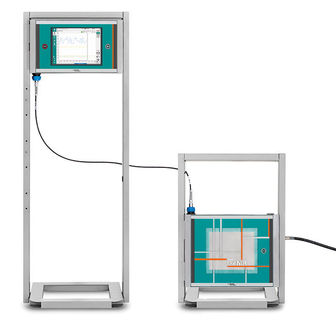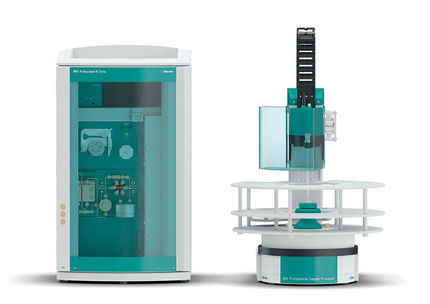To use all functions of this page, please activate cookies in your browser.
my.chemeurope.com
With an accout for my.chemeurope.com you can always see everything at a glance – and you can configure your own website and individual newsletter.
- My watch list
- My saved searches
- My saved topics
- My newsletter
Visible spectrumThe visible spectrum (or sometimes called the optical spectrum) is the portion of the electromagnetic spectrum that is visible to (can be detected by) the human eye. Electromagnetic radiation in this range of wavelengths is called visible light or simply light. A typical human eye will respond to wavelengths in air from about 380 to 750 nm.[1] The corresponding wavelengths in water and other media are reduced by a factor equal to the refractive index. In terms of frequency, this corresponds to a band in the vicinity of 400-790 terahertz. A light-adapted eye generally has its maximum sensitivity at around 555 nm (540 THz), in the green region of the optical spectrum (see: luminosity function). The spectrum does not, however, contain all the colors that the human eyes and brain can distinguish. Brown, pink, and magenta are absent, for example, because they need a mix of multiple wavelengths, preferably shades of red.
Wavelengths visible to the eye also pass through the "optical window", the region of the electromagnetic spectrum which passes largely unattenuated through the Earth's atmosphere (although blue light is scattered more than red light, which is the reason the sky is blue). The response of the human eye is defined by subjective testing (see CIE), but the atmospheric windows are defined by physical measurement. The "visible window" is so called because it overlaps the human visible response spectrum; the near infrared (NIR) windows lie just out of human response window, and the Medium Wavelength IR (MWIR) and Long Wavelength or Far Infrared (LWIR or FIR) are far beyond the human response region. The eyes of many species perceive wavelengths different from the spectrum visible to the human eye. For example, many insects, such as bees, can see light in the ultraviolet, which is useful for finding nectar in flowers. For this reason, plant species whose life cycles are linked to insect pollination may owe their reproductive success to their appearance in ultraviolet light, rather than how colorful they appear to our eyes. Product highlight
HistoryTwo of the earliest explanations of the optical spectrum came from Isaac Newton, when he wrote his Opticks, and from Goethe, in his Theory of Colours, although earlier observations had been made by Roger Bacon who first recognized the visible spectrum in a glass of water, four centuries before Newton discovered that prisms could disassemble and reassemble white light.[citation needed] Newton first used the word spectrum (Latin for "appearance" or "apparition") in print in 1671 in describing his experiments in optics. Newton observed that, when a narrow beam of sunlight strikes the face of a glass prism at an angle, some is reflected and some of the beam passes into and through the glass, emerging as different colored bands. Newton hypothesized that light was made up of "corpuscles" (particles) of different colors, and that the different colors of light moved at different speeds in transparent matter, with red light moving more quickly in glass than violet light. The result is that red light was bent (refracted) less sharply than violet light as it passed through the prism, creating a spectrum of colors.
Newton divided the spectrum into seven named colors: red, orange, yellow, green, blue, indigo, and violet (this order being popularly memorised by schoolchildren using the mnemonic ROY G. BIV). He chose seven colors out of a belief, derived from the ancient Greek sophists, that there was a connection between the colors, the musical notes, the known objects in the solar system, and the days of the week.[2][3] The human eye is relatively insensitive to indigo's frequencies, and some otherwise well-sighted people cannot distinguish indigo from blue and violet. For this reason some commentators including Isaac Asimov have suggested that indigo should not be regarded as a color in its own right but merely as a shade of blue or violet. Johann Wolfgang von Goethe contended that the continuous spectrum was a compound phenomenon. Whereas Newton narrowed the beam of light in order to isolate the phenomenon, Goethe observed that with a wider aperture, there was no spectrum - rather there were reddish-yellow edges and blue-cyan edges with white between them, and the spectrum only arose when these edges came close enough to overlap. All light travels at the same speed in a vacuum. The speed of light within a material is lower than the speed of light in a vacuum, and the ratio of speeds is known as the refractive index of the material. Because the refractive index (and thus the speed) of a wave in a material depends on its frequency (in accordance with a dispersion relation), light consisting of multiple frequencies—for instance white light—will be dispersed at the interface between the material and air or vacuum. Both water and glass can be used to demonstrate dispersion; a glass prism yields an optical spectrum from white light, and rainbows are an ideal example of natural refraction of the visible spectrum. Spectral colors
The familiar colors of the rainbow in the spectrum include all those colors that can be produced by visible light of a single wavelength only, the pure spectral or monochromatic colors. Although the spectrum is continuous and therefore there are no clear boundaries between one color and the next, the ranges above may be used as an approximation.[4] Spectroscopy
The scientific study of objects based on the spectrum of the light they emit is called spectroscopy. One particularly important application of spectroscopy is in astronomy, where spectroscopy is essential for analysing the properties of distant objects. Typically, astronomical spectroscopy utilises high-dispersion diffraction gratings to observe spectra at very high spectral resolutions. Helium was first detected through an analysis of the spectrum of the Sun; chemical elements can be detected in astronomical objects by emission lines and absorption lines; the shifting of spectral lines can be used to measure the redshift or blueshift of distant or fast-moving objects. The first exoplanets to be discovered were found by analysing the doppler shift of stars at such a high resolution that variations in their radial velocity as small as a few metres per second could be detected: the presence of planets was revealed by their gravitational influence on the stars analysed, as revealed by their motion paths. Color display spectrumColor displays (e.g., computer monitors or televisions) mix red, green, and blue color to approximate the color spectrum. In the illustration, the narrow red, green and blue bars show the relative mixture of these three colors used to produce the color directly above. See alsoWikisource has original text related to this article:
a debate whether indigo is the color meant on the spectrum
References
Categories: Electromagnetic spectrum | Optical spectrum |
||||||||||||||||||||||||||||||
| This article is licensed under the GNU Free Documentation License. It uses material from the Wikipedia article "Visible_spectrum". A list of authors is available in Wikipedia. | ||||||||||||||||||||||||||||||







